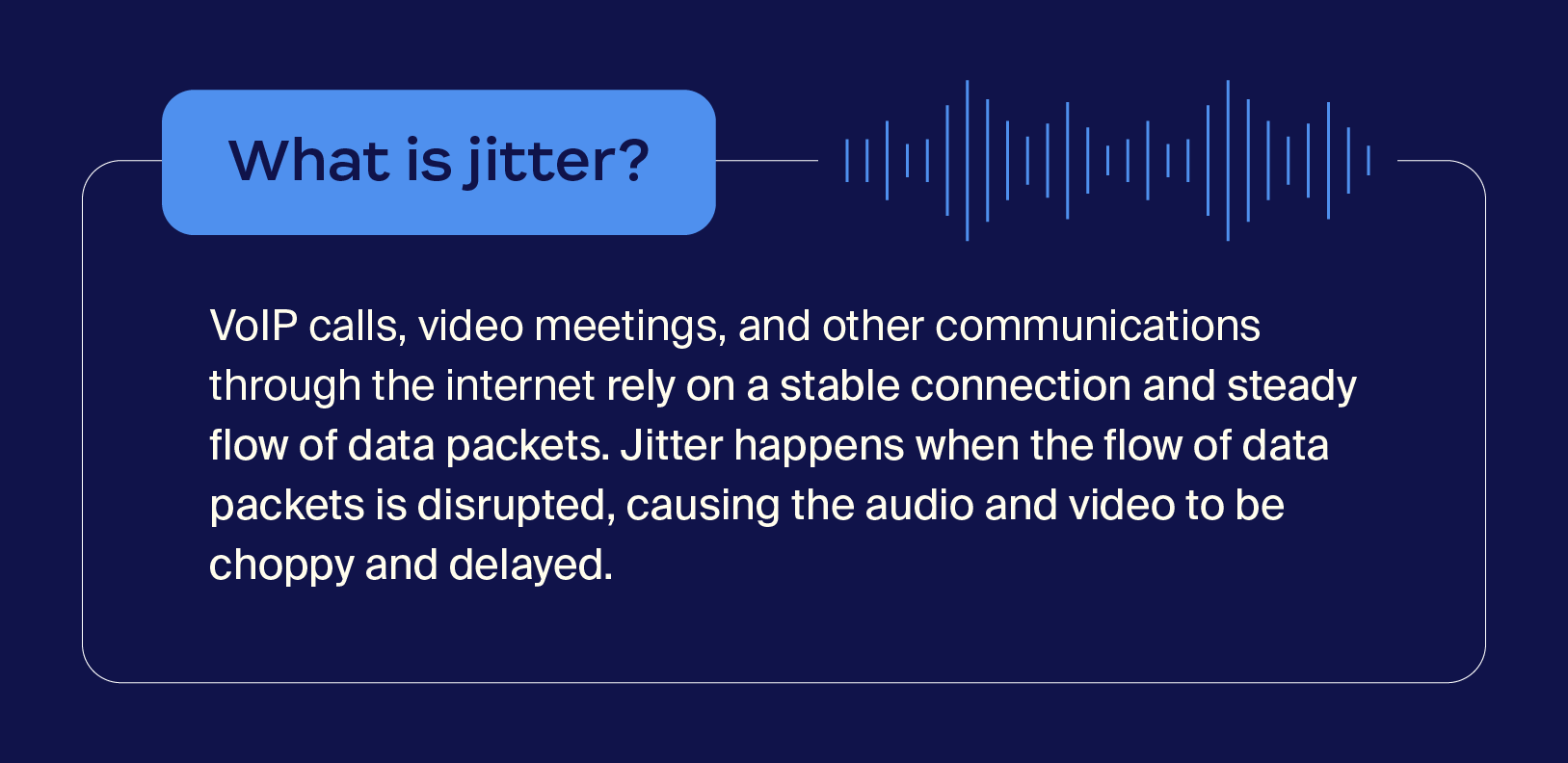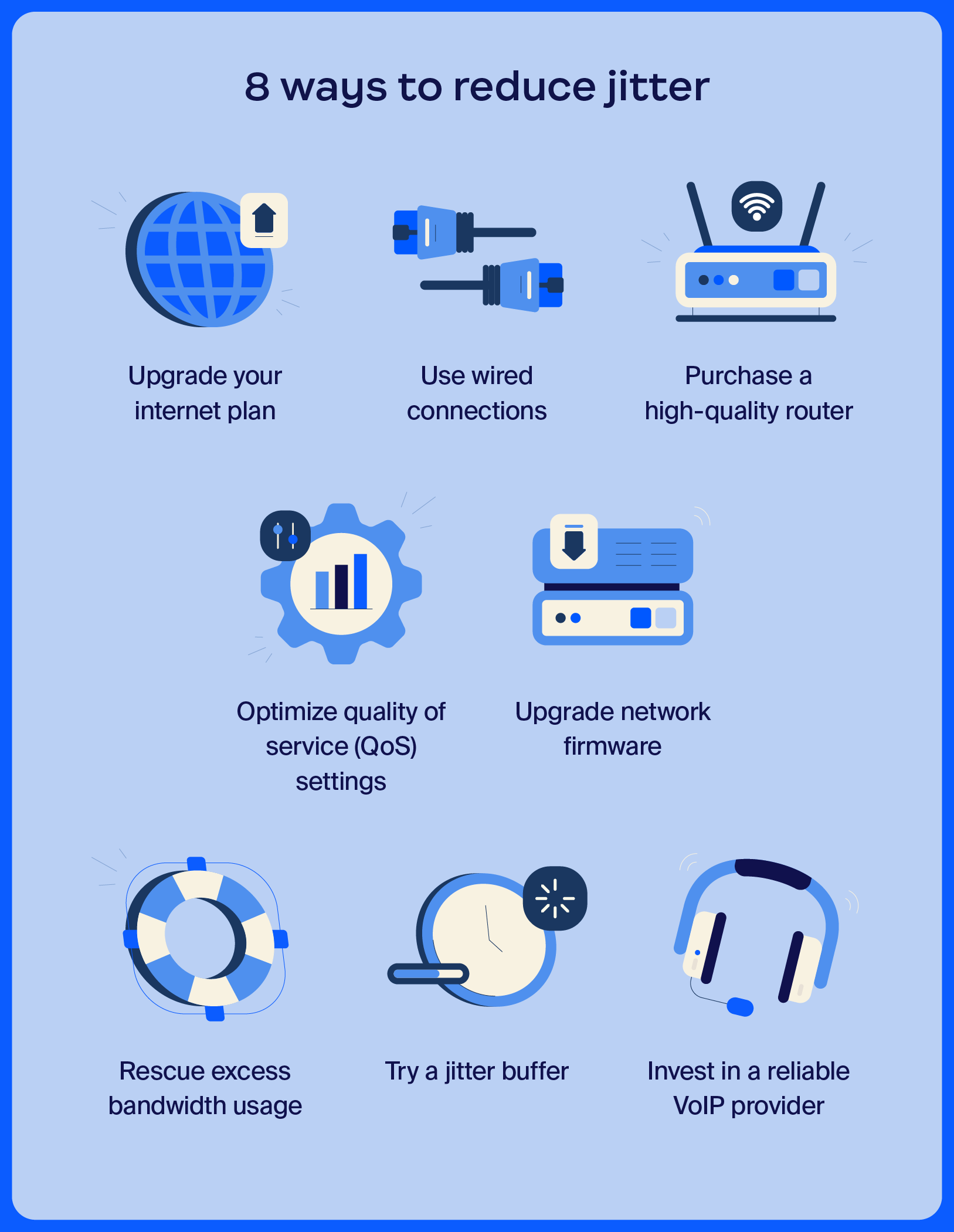
Meet Zoom AI Companion, your new AI assistant!
Boost productivity and team collaboration with Zoom AI Companion, available at no additional cost with eligible paid Zoom plans.
Updated on February 14, 2025
Published on February 14, 2025


Your contact center should have clear, uninterrupted communication on every call, but jitter can present issues that drastically affect call quality. What is jitter? Jitter is a common network issue that hinders the clarity of your inbound and outbound calls, which creates a poor customer experience and frustration for agents.
In this post, we uncover the mystery of what jitter is, why it happens, and how to reduce jitter. With some simple steps, you can reduce jitter in your contact center and know exactly what to do when it happens.
Jitter is a technical term that refers to the delays of data packets as they travel across a network. Modern contact centers use something called Voice over Internet Protocol (VoIP), where data packets transfer the communication between both parties on a call. When you experience jitter, the data packets aren’t flowing smoothly, causing audio to sound choppy, robotic, or delayed.
Jitter impacts more than just call quality. The delayed speed of data packet transfers also decreases the quality of video calls, livestreaming, and chat messages. Basically, it delays and diminishes the quality of anything you do online.

Communication should be seamless, whether you’re making outbound sales calls or inbound customer service calls, but jitter creates major challenges. Some of the negative effects of jitter include:
While jitter causes a variety of problems with VoIP and other applications, low levels of jitter don’t have a noticeable effect. The “acceptable” amount of jitter can vary from application to application, but a delay of roughly 30 milliseconds (ms) typically won’t cause distortion or disruptions.
Some applications have a higher tolerance for jitter before they start losing quality. Below are some thresholds for when jitter is acceptable:
To test jitter, you can use one of many free, easy-to-use websites like Fusion Connect. In addition to jitter, it also shows your upload speed, download speed, and network latency.

To find the right solution to reduce jitter, you’ll first need to figure out the cause. Here are some of the most common causes of jitter to look out for:

Now that you have a better understanding of what jitter is and how it impacts call quality, let’s explore some simple ways to minimize jitter. By implementing these strategies, your contact center can significantly enhance the overall customer experience and reduce obstacles for your agents.
A lack of bandwidth is a primary culprit when it comes to jitter. Your contact center may be using a lower-tier internet plan with slow download and upload speeds. Upgrading your plan is like adding additional lanes on a road that allows data packets to flow more freely.
Wireless technology provides the convenience of minimizing physical cord clutter, but it comes with drawbacks that can lead to jitter. Using wired connections that go straight to your switches and routers eliminates interference from other wireless networks, reducing the possibility of jitter.
Similar to upgrading your internet plan, investing in a high-quality router may reduce or eliminate your jitter problems. Routers have bandwidth specifications, and a higher-quality router lets you transfer more data without as much congestion.
Simply adjusting QoS settings may reduce your jitter. Your routers and switches have QoS settings, or you may be able to change them through your ISP. You can often prioritize real-time applications like VoIP, video streaming, and more, optimizing your network to avoid jitter.
Firmware is the software that makes your network hardware run smoothly. If the firmware in your router and switches is out of date, it can lead to jitter. You can often go to the manufacturer’s website to see if there are any firmware updates for your equipment.
Each device on a network uses bandwidth, and certain activities can use more bandwidth than others. For example, if you work from home and other people in the house are streaming videos and playing games online, they’re using bandwidth that can lead to jitter. If you don’t upgrade your internet plan, you’ll need to find ways to reduce bandwidth usage from the other devices.
During VoIP calls, data packets are sent back and forth on the network, and sometimes they arrive out of order due to network congestion. A jitter buffer is a way to set up your network, acting as a sort of waiting room that can hold packets, sort them, and send them in the proper order. This can help smooth out any delays or gaps that cause choppy calls.
If you try all of the above methods to reduce jitter without good results, you may have an unreliable VoIP provider. Much like any other service or utility, some providers are better than others. It may be time to seek a provider that can provide a reliable connection even in low-bandwidth environments to give your contact center the quality service it deserves.
One of the best ways to reduce jitter is to use top-of-the-line VoIP services. Zoom Contact Center is an industry leader in VoIP technology. In addition to VoIP services, our software can help improve customer satisfaction, boost agent productivity, and provide your team with detailed insights to improve your operations.
With advanced features like AI-powered call routing and seamless integration with a variety of popular CRM platforms, Zoom Contact Center can help you deliver exceptional customer service and streamline day-to-day tasks. Book a demo today to see what Zoom Contact Center can do for you.